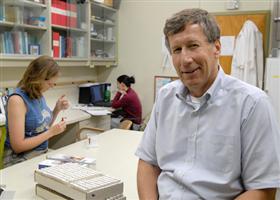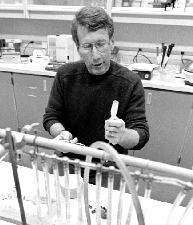Former Professor and Associate Chair of the Department of Biological Sciences until his Passing in 2012

Dr. Alfred Dufty, Jr was an esteemed colleague, faculty member, graduate advisor, and friend to many. Read more about Dr. Dufty from his colleague, Dr. Jim Belthoff (professor and former chair of Boise State University Department of Biological Sciences and interim director of the Raptor Research Center) in the memorial article he wrote, published in The Auk: Ornithological Advances (OUP) in 2012.
Dr. Dufty’s legacy of scholarship and excellence continued on at Boise State University. Many graduate students have been able to present their research at professional conferences and meetings through the Alfred M. Dufty, Jr. Award.
Positions Held
- Adjunct assistant professor at Hampden-Sydney College and State University of New York
- Professor at Boise State University (Biology, 1988-2012)
- Director of Graduate Studies (Biology, 1998-2003)
- Associate Department Chair (Biology, 2003-2005)
- Associate Dean of the Graduate College (2005-2012)
Academic Degrees
- A. B., Princeton University, 1972
- M.S., State University of New York at Binghamton, 1976
- Ph.D., State University of New York at Binghamton, 1981
- Postdoctoral Positions: The Rockefeller University, with Drs. Peter Marler and John Wingfield, 1981-1988
Interests While at Boise State

- Behavioral endocrinology
- Feathers, breeding sites, and stable isotopes
- Natal dispersal
- Brood parasitism
Radioimmunoassay Laboratory

The Radioimmunoassay (RIA) Laboratory at Boise State University functioned under the direction of Dr. Alfred Dufty. It was used to measure circulating levels of steroid hormones (e.g., testosterone, estradiol, corticosterone) in blood plasma. The protocol involved initial extraction of hormones from the blood and separation of individual hormones by column chromatography. The RIA itself involved the use of tritium-labeled (hot) hormone to compete with the unlabeled (cold) hormone for binding sites on a hormone-specific antibody. A scintillation counter measured the ratio of hot:cold hormone attached to the antibody in the sample, and a determination was made based on a comparison with known standards. Dr. Dufty used the technique to investigate the physiological mechanism underlying avian responses to handling stress, dominance relationships, and changes in sex steroid hormones during the breeding season. Both graduate and undergraduate students learned the RIA technique, and the skills involved were transferable to many other laboratory situations.
Publications:
- Whitman, Buddy & Breuner, Creagh & Dufty, Alfred. (2011). The effects of neonatal handling on adrenocortical responsiveness, morphological development and corticosterone binding globulin in nestling American kestrels (Falco sparverius). General and comparative endocrinology. 172. 260-7. 10.1016/j.ygcen.2011.03.009.
- Butler, Michael & Whitman, Buddy & Dufty, Alfred. (2009). Nest Box Temperature and Hatching Success of American Kestrels Varies with Nest Box Orientation. Wilson Journal of Ornithology – WILSON J ORNITHOL. 121. 10.1676/08-124.1.
- Butler, Michael & Leppert, Lynda & Dufty, Alfred. (2009). Effects of Small Increases in Corticosterone Levels on Morphology, Immune Function, and Feather Development Physiological and biochemical zoology : PBZ. 83. 78-86. 10.1086/648483.
- Leppert, Lynda & Dufty, Alfred & Stock, Sarah & Oleyar, M & Kaltenecker, Greg. (2008). Survey of Blood Parasites in Two Forest Owls, Northern Saw-whet Owls and Flammulated Owls, of Western North America Journal of wildlife diseases. 44. 475-9. 10.7589/0090-3558-44.2.475.
- Dufty, Alfred. (2008). Stress Responsiveness in Nestlings: A Comparison of Two Sampling Techniques 125. 10.1525/auk.2008.125.1.225.
- Staley, Airica & Blanco, Juan & Dufty, Alfred & Wildt, David & Monfort, Steven. (2007). Fecal steroid monitoring for assessing gonadal and adrenal activity in the golden eagle and peregrine falcon Journal of comparative physiology. B, Biochemical, systemic, and environmental physiology. 177. 609-22. 10.1007/s00360-007-0159-2.
- Vercken, Elodie & Fraipont, Michelle & Dufty, Alfred & Clobert, Jean. (2007). Mother’s timing and duration of corticosterone exposure modulate offspring size and natal dispersal in the common lizard (Lacerta vivipara) Hormones and behavior. 51. 379-86. 10.1016/j.yhbeh.2006.12.006.
- Leppert, Lynda & Zadorozhny, Tatiana & Belthoff, James & Dufty, Alfred & Stock, Sarah & Kaltenecker, Greg & Smith, James. (2006). Sex Identification in Four Owl Species from Idaho: DNA and Morphometrics 40.10.3356/0892-1016(2006)40[291: SIIFOS]2.0.CO;2.
- Donohue, Kara & Dufty, Alfred & Jr, Alfred. (2006). Sex determination of Red‐tailed Hawks (Buteo jamaicensis calurus) using DNA analysis and morphometrics Journal of Field Ornithology. 77. 74 – 79. 10.1111/j.1557-9263.2006.00003.x.
- Dufty, Alfred & Crandall, Meredeth. (2005). Corticosterone Secretion in Response to Adult Alarm Calls in American Kestrels Alfred Dufty. 76. 10.1648/0273-8570-76.4.319.
- Meylan, Sandrine & Dufty, A.M & Clobert, Jean. (2003). The effect of transdermal corticosterone application on plasma corticosterone levels in pregnant Lacerta vivipara Comparative biochemistry and physiology. Part A, Molecular & integrative physiology. 134. 497-503. 10.1016/S1095-6433(02)00343-4.
- Staley, A. & Blanco, J.M. & Dufty, Alfred & Wildt, D & Monfort, S. (2003). Noninvasive Fecal Steroid Monitoring Provides Insight into Gonadal and Adrenal Function in the Golden Eagle ( Aquila chrysaetos ) and peregrine falcon ( Falco peregrinus ).
- Dufty, Alfred & Clobert, Jean & Moller, Anders. (2002). Hormones, developmental plasticity and adaptation Trends in Ecology & Evolution. 17. 190-196. 10.1016/S0169-5347(02)02498-9.
- Dufty, Alfred & Belthoff, James. (1999). Proximate Mechanisms of Dispersal: the Role of Hormones and Body Condition.
- Heath, Julie & Dufty, Alfred. (1998). Body Condition and the Adrenal Stress Response in Captive American Kestrel Juveniles 71. 10.1086/515888.
- Ball, Gregory & Dufty, A.. (1998). Assessing Hormonal Responses to Acoustic Stimulation 10.1007/978-3-642-76220-8_12.
- Dufty, Alfred & Belthoff, James. (1997). Corticosterone and the Stress Response in Young Western Screech-Owls: Effects of Captivity, Gender, and Activity Period Physiological zoology. 70. 143-9. 10.1086/639564.
- Belthoff, James & Dufty, Alfred. (1995). Activity Levels and the Dispersal of Western Screech-Owls, Otus kennicottii 50. 10.1006/anbe.1995.0272.
- Dufty, Alfred & Belthoff, James & Gauthreaux, Sidney. (1994). Plumage Variation, Plasma Steroids, and Social Dominance in Male House Finches 96. 10.2307/1369464.
- Wingfield, John & Hegner, Robert & Dufty, Alfred & Ball, Gregory. (1990). The “Challenge Hypothesis”: Theoretical Implications for Patterns of Testosterone Secretion, Mating Systems, and Breeding Strategies American Naturalist. 136. 829-846. 10.1086/285134.
- Dufty, Alfred & Wingfield, John. (1990). Endocrine Response of Captive Male Brown-Headed Cowbirds to Intrasexual Social Cues 92. 10.2307/1368681.
- Dufty, Alfred. (1989). Testosterone and survival: A cost of aggressiveness?. Hormones and behavior. 23. 185-93. 10.1016/0018-506X(89)90059-7.
- Marler, Peter & Peters, Susan & Ball, Gregory & Dufty, Alfred & Wingfield, John. (1988). The role of sex steroids in the acquisition of birdsong Nature. 336. 770-2. 10.1038/ 33677 0a0.
- Sherwood, Nancy & Wingfield, John & Ball, Gregory & Dufty, Alfred. (1988). Identity of gonadotropin-releasing hormone in passerine birds: Comparison of GnRH in song sparrow (Melospiza melodia) and starling (Sturnus vulgaris) with five vertebrate GnRHs. General and comparative endocrinology. 69. 341-51. 10.1016/0016-6480(88)90024-X.
- Dufty, Alfred & Wingfield, John. (1986). The influence of social cues on the reproductive endocrinology of male brown-headed cowbirds: Field and laboratory studies Hormones and behavior. 20. 222-34. 10.1016/0018-506X(86)90020-6.
- Dufty, Alfred. (1986). Singing and the Establishment and Maintenance of Dominance Hierarchies in Captive Brown-Headed Cowbirds 19. 10.1007/BF00303842.
- Dufty, Alfred. (1982). Response of brown-headed cowbirds to simulated conspecific intruders Animal Behaviour. 30. 1043-1052. 10.1016/S0003-3472(82)80194-2.
- Dufty, Alfred. (1982). Movements and Activities of Radio Tracked Brown-Headed Cowbirds. 99.
- Dufty, Alfred & Smith, Adam & Donohue, Kara. (2008). Intra-Feather and Intra-Individual Variation in the Stable-Hydrogen Isotope (δD) Content of Raptor Feathers.
- Belthoff, James & Dufty, Alfred. (1997). Corticosterone and Dispersal in Western Screech-Owls (Otus kennicottii).
- Dufty, Alfred & Staley, A. & Blanco, J. & Wildt, D & Monfort, S. (2003). Noninvasive Fecal Steroid Measures for Assessing Gonadal and Adrenal Function in Raptors.
- Belthoff, James & Dufty, Alfred. (1998). Corticosterone, Body Condition, and Locomotor Activity: a Model for Natal Dispersal 54.
- Dufty, Alfred & Belthoff, James. (1994). Plumage Variation, Plasma Steroids, and Social Dominance in Wintering Male House Finches.
- Belthoff, James & Dufty, Alfred & Able, Kenneth. Patterns of Corticosterone Secretion in House Finches from Sedentary and Migratory Ranges in North America.
- Dufty, Alfred & Belthoff, James. Hormones, the Immune System and Dispersal.
- Dufty, Alfred & Belthoff, James & Ellsworth, Ethan. Response of Male brown-Headed Cowbirds ( Molothrus ater ) to Playbacks of Flight Whistles from Different Dialects.
- Dufty, Alfred & Belthoff, James. A New Model for Dispersal in Screech-Owls: Corticosterone, Body Condition and Behavior.
- Dufty, Alfred & Belthoff, James. Why do Raptors Disperse? Some Insights Based on Physiology and Hormones.
- Dufty, Alfred & Belthoff, James. Hormonal Correlates of Natal Dispersal in Birds.
- Dufty, Alfred & Belthoff, James. Aspects of Hormones and Behavior in Birds.
- Dufty, Alfred & Clobert, Jean & Moller, Anders. Hormones, Development and Adaptation.
- Dufty, Alfred & Belthoff, James & Herting, B. Steroid Hormones in Western Screech-Owls: Age, Gender, and Breeding Stage.